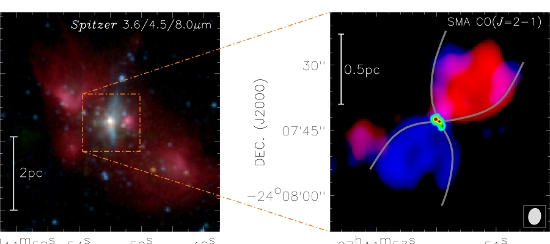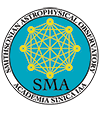|
SMA observations reveal a well defined wide-angle molecular outflow in a luminous (50,000 times the solar luminosity) star-forming region, G240.31+0.07. In a Spitzer color composit image (the left panel, with the 3.6, 4.5, and 8.0 micron emission coded in blue, green, and red, respectively), the central area of the region stands out by virtue of excess in the 3.6 and 4.5 micron emission, indicative of scattered light and shocked H2 emission caused by outflow activity. In the right panel, SMA CO (2-1) observation at 3" resolution is shown in a color composite image with approaching material coded in blue and receding material in red. As outlined by two gray curves, a bipolar, wide-angle, quasi-parabolic outflow is clearly seen in the CO map. The outflow possesses a huge amount of molecular gas, about 100 times the mass of the Sun. Towards the geometric center of the outflow, SMA 1.3 mm continuum observation at 1" resolution (shown in color filled contours in the right panel) yields three dense cores (denoted by three crosses), with the middle one forming at least one high-mass protostar and proposed as the driving source of the outflow. Striking similarities in both morphology and kinematics between the outflow and some low-mass molecular outflows suggest that the central high-mass star forms as a scaled-up version of low-mass star formation.
Science Publication
Keping Qiu (Harvard-Smithsonian CfA, Nanjing University), et al.
Submillimeter Array Observations of the Molecular Outflow in High-Mass Star-Forming Region G240.31+0.07,
2009, ApJ, 696, 66 (ADS)

Keping Qiu (Harvard-Smithsonian CfA, Nanjing University), 2009
Click here for a larger view
| 

